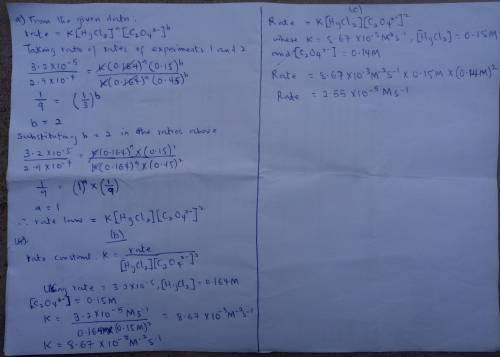
Chemistry, 25.09.2020 01:01 22chandlerlashley
Consider the following reaction between mercury(II) chloride and oxalate ion.
2 HgCl2(aq) + C2O42-(aq) 2 Cl -(aq) + 2 CO2(g) + Hg2Cl2(s)
The initial rate of this reaction was determined for several concentrations of HgCl2 and C2O42-, and the following rate data were obtained for the rate of disappearance of C2O42-.
Experiment [HgCl2] (M) [C2O42-] (M) Rate (M/s)
1 0.164 0.15 3.2 10-5
2 0.164 0.45 2.9 10-4
3 0.082 0.45 1.4 10-4
4 0.246 0.15 4.8 10-5
(a) What is the rate law for this reaction?
k[HgCl2]2[C2O4-2]
k[HgCl2]2[C2O4-2]1/2
k[HgCl2][C2O4-2]2
(b) What is the value of the rate constant?
M-2s-1
(c) What is the reaction rate when the concentration of HgCl2 is 0.15 M and that of C2O42- is 0.14 M if the temperature is the same as that used to obtain the data shown above?
M/s

Answers: 1


Another question on Chemistry

Chemistry, 22.06.2019 01:00
What are the variables in gay-lussac’s law? pressure and volume pressure, temperature, and volume pressure and temperature volume, temperature, and moles of gas
Answers: 1

Chemistry, 22.06.2019 08:00
This classification of drug typically changes the brain's chemistry and reduces its ability to create its own endorphins.
Answers: 1

Chemistry, 22.06.2019 17:40
If 3 moles of a compound use 24 j of energy in a reaction, what is the a hreaction in j/mol?
Answers: 1

Chemistry, 22.06.2019 19:30
What is the mass of oxygen gas is consumed in a reaction that produces 4.60mol so2
Answers: 3
You know the right answer?
Consider the following reaction between mercury(II) chloride and oxalate ion.
2 HgCl2(aq) + C2O42-(...
Questions


Computers and Technology, 02.07.2019 06:30


English, 02.07.2019 06:30

Social Studies, 02.07.2019 06:30



Geography, 02.07.2019 06:30

Mathematics, 02.07.2019 06:30

Mathematics, 02.07.2019 06:30


Mathematics, 02.07.2019 06:30

Mathematics, 02.07.2019 06:30


Mathematics, 02.07.2019 06:30



Biology, 02.07.2019 06:30





